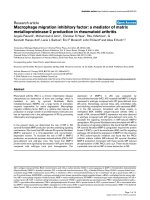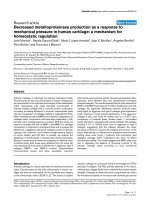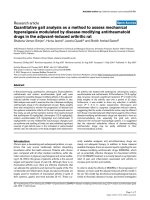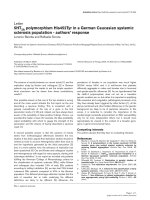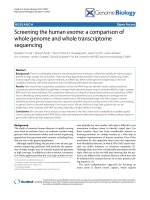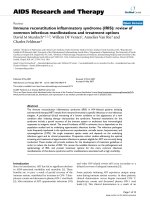Báo cáo y học: " Extrathoracic airway hyperresponsiveness as a mechanism of post infectious cough: case report" doc
Bạn đang xem bản rút gọn của tài liệu. Xem và tải ngay bản đầy đủ của tài liệu tại đây (163.99 KB, 4 trang )
BioMed Central
Page 1 of 4
(page number not for citation purposes)
Cough
Open Access
Case report
Extrathoracic airway hyperresponsiveness as a mechanism of post
infectious cough: case report
Nicole M Ryan
1,2
and Peter G Gibson*
1,2
Address:
1
School of Medicine and Public Health, The University of Newcastle, Callaghan, NSW 2308, Australia and
2
Hunter Medical Research
Institute, Department of Respiratory and Sleep Medicine, John Hunter Hospital, Locked Bag 1, Hunter Region Mail Centre, NSW, 2310, Australia
Email: Nicole M Ryan - ; Peter G Gibson* -
* Corresponding author
Abstract
Post-infectious cough is a common diagnosis in people with chronic cough. However, the specific
infectious aetiology and cough mechanisms are seldom identified.
We report a case of chronic cough after Mycoplasma pneumoniae lower respiratory tract infection
with extrathoracic airway hyperresponsiveness as the cough mechanism. Extrathoracic airway
hyperresponsiveness may be a common mechanism in post-infectious cough which may be useful
both diagnostically and therapeutically since chronic cough with extrathoracic airway
hyperresponsiveness responds to speech pathology treatment.
Background
Post-infectious cough is a common diagnosis, especially
in primary care settings, although a specific infectious
aetiology is rarely confirmed. Aside from pertussis, the
role of other infectious agents in chronic cough is poorly
understood. In specialist clinics chronic cough occurs in
association with asthma, rhinitis, gastro-oesophageal
reflux (GERD), and ACE inhibitor use [1]. However, even
in these settings, a respiratory infection is often reported
at the onset of chronic cough. Extrathoracic airway hyper-
responsiveness (EAHR) represents variable extrathoracic
airflow obstruction following inhalation provocation test-
ing [2-6]. It manifests as a fall in inspiratory airflow during
challenge with histamine, exercise, or hypertonic saline.
EAHR is a feature of cough due to ACE inhibitor use [2],
rhinosinusitis [3,4] and GERD [5], and possibly asthma
[6]. The mechanism of post-infectious cough is not
known, however, upper airway sensory hyperresponsive-
ness might be one important mechanism in driving cough
in some entities of CC [7] and this current case suggests
that EAHR may be a useful objective marker and relevant
mechanism in post infectious cough.
Case presentation
A 60 year old non-smoking male presented to the Emer-
gency Department with a non-productive cough and cold
symptoms. For the past week he had been confined to bed
and reported severe bodily pain, a troublesome cough and
shortness of breath when showering and toileting. His
temperature was 38.6°C. Physical examination of the
chest was unremarkable and chest radiograph showed
increased bronchial markings centrally. Arterial Blood
Gas results breathing room air were: pH 7.46, pCO
2
4.6
kPa, pO
2
6.9 kPa. He was commenced on oral roxithromy-
cin 150 mg bd, inhaled salbutamol 100 ug 2 puffs qid,
and analgesia, and continued pre-existing carbamazepine
300 mg bd for controlled epilepsy (a recent onset condi-
tion) and thyroxine 50/100 mcg on alternative days for
hypothyroidism which had developed five years prior. He
was subsequently changed to oral azithromycin 500 mg,
Published: 4 August 2008
Cough 2008, 4:7 doi:10.1186/1745-9974-4-7
Received: 1 April 2008
Accepted: 4 August 2008
This article is available from: />© 2008 Ryan and Gibson; licensee BioMed Central Ltd.
This is an Open Access article distributed under the terms of the Creative Commons Attribution License ( />),
which permits unrestricted use, distribution, and reproduction in any medium, provided the original work is properly cited.
Cough 2008, 4:7 />Page 2 of 4
(page number not for citation purposes)
improved and was discharged on day 5. Acute and conva-
lescent serology confirmed recent infection with Myco-
plasma pneumoniae (antibody titre 1:1280 (ref range <
1:40).
At a seven week follow-up visit he described persistent
cough, inspiratory dyspnoea, voice changes (characteris-
tics common to paradoxical vocal cord movement
(PVCM) and EAHR disorders) and fatigue. Hypertonic
saline provocation test was requested and conducted 2
months later.
Spirometry was FEV
1
84% predicted, FVC 86% predicted,
FEV
1
/FVC 78%; and FIF
50%
5.22 L/sec. Hypertonic (4.5%)
saline provocation challenge identified EAHR with atten-
uation of the inspiratory flow curve. The FIF
50%
decreased
by 39% to 3.20 L/s at a cumulative saline dose of 10.59
mL (figure 1, solid line). The fall in FEV
1
(12%) was
within normal limits. A trial of fluticasone/salmeterol and
nedocromil sodium was commenced.
The patient's cough and dyspnoea had greatly improved
by three months. One year later the cough had resolved
completely and an inspiratory/expiratory flow volume
curve was normal. There was no EAHR or bronchial
hyperresponsiveness after repeat hypertonic saline chal-
lenge (figure 1, dotted line), fall in FEV
1
remained within
normal limits (8%) and laryngoscopy showed no poste-
rior chinking during inspiration and no paradoxical vocal
cord movement (PVCM).
Discussion
This case report describes Mycoplasma pneumoniae respi-
ratory tract infection as a cause of persistent cough, occur-
ring in association with EAHR. EAHR was demonstrated
by a 39% fall in inspiratory flow during hypertonic saline
challenge. The cough resolved as the EAHR resolved.
Extrathoracic airway sensory hyperresponsiveness might
be an important mechanism in driving cough in some
entities of chronic cough (CC) [7]. This case report
extends these data to show that transient EAHR can occur
with post infectious cough.
Hypertonic saline provocation dose response curve for FIF
50%
prior to treatment (demonstrating extrathoracic airway hyper-responsiveness) and after treatmentFigure 1
Hypertonic saline provocation dose response curve for FIF
50%
prior to treatment (demonstrating extrathoracic airway hyper-
responsiveness) and after treatment. Solid line = pre treatment. Dotted line = post treatment.
Dose Response Curve
-5.0
0.0
5.0
10.0
15.0
20.0
25.0
30.0
35.0
40.0
0.1 1.0 10.0 100.0
Cumulative Dose (mL)
%Fall FIF50
38.7% fall
Cough 2008, 4:7 />Page 3 of 4
(page number not for citation purposes)
It has previously been proposed [8] that some patients
with CC sustain vagal injury from respiratory infection
and that airway hyperresponsiveness may persist beyond
resolution of the acute upper respiratory tract infection
(URTI). This hyperresponsiveness could decrease the
cough threshold to irritating stimuli resulting in higher
susceptibility to chemical or mechanical stimulation of
the cough reflex. Transient post-infectious bronchial
(intrathoracic) hyperresponsiveness is well recognised
[9]. This case report identifies transient EAHR as an addi-
tional relevant mechanism associated with post infectious
cough.
These observations have implications for the treatment of
post infectious cough. There may be a role for inhibition
of neuropeptide release, by cromoglycate, nedocromil, or
specific neuropeptide antagonists in post infectious
cough. Fontana et al [10] evaluated the effects of
nedocromil sodium administration on cough threshold
in a placebo-controlled study of healthy subjects. They
found a significant increase in cough threshold values
after nedocromil and an unaffected result after placebo
suggesting that nedocromil sodium administration may
be useful for treating cough, especially when the use of
centrally acting antitussive drugs should be avoided.
These agents are also of benefit in ACE Inhibitor cough,
which is associated with EAHR. Also, given the similarity
between PVCM and EAHR [11], adapting techniques used
by speech language therapists that were developed for
PVCM maybe of benefit for post infectious cough with
EAHR. In PVCM the vocal cords adduct episodically and
involuntarily during inspiration. This phenomenon leads
to reduced inspiratory airflow associated with signs of stri-
dor and a perception of dyspnoea characterised by the ina-
bility to inspire sufficient air [12]. EAHR is thought to be
the primary underlying pathophysiology of PVCM [13].
Speech language therapy has been shown to be a success-
ful treatment in chronic persistent cough. Vertigan et al
[14] conducted a randomised placebo-controlled trial in
87 patients with CC persisting despite medical treatment.
Half of these patients had EAHR and symptoms of PVCM.
Patients were randomly assigned to receive either a specif-
ically designed speech pathology intervention or placebo
intervention. Participants in the treatment group were
found to have a significant reduction in cough with 88%
having a successful outcome compared to 14% in the pla-
cebo group. In a comprehensive literature review, Galli-
van et al [15] presented cases of episodic paroxysmal
laryngospasm with definitive diagnosis by videolaryngos-
copy of paradoxical vocal cord adduction during inspira-
tion and extrathoracic airway obstruction by attenuation
of the inspiratory portion of the flow volume curve. Prior
to this, Christopher et al [16] identified 5 patients with a
functional disorder of the vocal cords that mimicked
attacks of bronchial asthma, that is paroxysms of wheez-
ing and dyspnoea refractory to standard asthma therapy.
During episodes of wheezing, the maximal expiratory and
inspiratory flow-volume relationship was consistent with
variable extrathoracic obstruction. Laryngoscopy con-
firmed adduction of the true vocal and false vocal cords.
While during asymptomatic periods the maximal flow-
volume relationship and laryngoscopic examination were
normal. Patients were not aware of the vocal-cord dys-
function, which uniformly and dramatically responded to
speech language therapy where they were taught to focus
attention away from the larynx and the inspiratory phase
of breathing during episodes of wheeze and dyspnoea
[16]. EAHR may be a useful objective assessment measure
to characterise laryngeal dysfunction in chronic cough.
EAHR can be assessed during inhalational provocation
challenge. We prefer the use of hypertonic saline to assess
EAHR as it is known to provoke neuropeptide release
from nonadrenergic-noncholinergic nerves, which are
prevalent in the larynx. Inhaled histamine to assess EAHR
has been successfully used before [6] where the histamine
concentration causing a 25% fall in mid-inspiratory flow
was used as the respective threshold of EAHR. It was
found that patients presenting with cough as the sole
symptom had significantly greater probability of having
EAHR. Histamine can however cause oedema of the vocal
cords furthering our preference for hypertonic saline stim-
ulus. Methacholine challenge appears to be a less sensitive
stimulus for EAHR. This is likely because of its specific
action on cholinergic receptors in airway smooth muscle,
and unproven action on laryngeal responses. Exercise can
also be used to assess EAHR, although quantification of
the stimulus may be more difficult.
Our male patient had pre existing hypothyroidism which
has been associated with idiopathic chronic cough and
airway inflammation [17]. This is unlikely to be the pri-
mary cause of cough in the patient as the cough developed
after a well-documented Mycoplasma pneumoniae lower
respiratory tract infection that occurred some 5 years after
the onset of hypothyroidism. Further there is a female pre-
dominance in cases of idiopathic CC and its association
with mild chronic lymphocytic airway inflammation [18].
It is however possible that a pre-existing auto-immune
lymphocytic bronchitis had a permissive effect on the
occurrence of post-Mycoplasma chronic cough. Prospec-
tive studies would be helpful in evaluating this possibility.
Conclusion
Post infectious cough can occur with EAHR. There are
opportunities to further investigate the frequency and
treatment of EAHR as a mechanism of post-infectious
cough with speech pathology.
Publish with BioMed Central and every
scientist can read your work free of charge
"BioMed Central will be the most significant development for
disseminating the results of biomedical research in our lifetime."
Sir Paul Nurse, Cancer Research UK
Your research papers will be:
available free of charge to the entire biomedical community
peer reviewed and published immediately upon acceptance
cited in PubMed and archived on PubMed Central
yours — you keep the copyright
Submit your manuscript here:
/>BioMedcentral
Cough 2008, 4:7 />Page 4 of 4
(page number not for citation purposes)
Competing interests
The authors declare that they have no competing interests.
Authors' contributions
NR carried out the flow volume loop and hypertonic
saline challenge testing, assisted with laryngoscopy, col-
lected and reviewed data, participated in the design and
drafted the manuscript. PG performed patient physical
examination and laryngoscopy, initiated inpatient tests
and prescribed medication. PG also participated in the
case report design and coordination of the manuscript.
All authors read and approved the final manuscript.
Consent
Written informed consent was obtained from the patient
for publication of this case report. A copy of the written
consent is available for review by the Editor-in-Chief of
this journal.
Acknowledgements
Sources of Funding: Nicole M Ryan holds a PhD scholarship from the
NHMRC CCRE in Respiratory and Sleep Medicine, Australia.
Peter Gibson is an NHMRC Practitioner Fellow.
References
1. Morice AH: The diagnosis and management of chronic cough.
European Respiratory Journal 2004, 24:481-492.
2. Bucca C, Rolla G, Pinna G, Oliva A, Bugiani M: Hyperresponsive-
ness of the extrathoracic airway in patients with captopril
induced cough. Chest 1990, 98:1133-1137.
3. Bucca C, Rolla G, Scappaticci E, Chiampo F, Bugiani M, Magnano M,
D'Alberto M: Extrathoracic and intrathoracic airway respon-
siveness in sinusitis. Journal of Allergy and Clinical Immunology 1995,
95:52-59.
4. Rolla G, Colagrande P, Scappaticci E, Bottomicca F, Magnano M,
Brussino L, Dutto L, Bucca C: Damage of the pharyngeal mucosa
and hyperresponsiveness of airway in sinusitis. Journal of Allergy
and Clinical Immunology 1997, 100:52-57.
5. Rolla G, Colagrande P, Magnano M, Debermardi V, Dutto L, Delpiano
L, Cassolino P, Bucca C: Extrathoracic airway dysfunction in
cough associated with gastroesophageal reflux. Journal of
Allergy and Clinical Immunology 1998, 102:204-209.
6. Bucca C, Rolla G, Brussino L, De Rose V, Bugiani M: Are asthma-
like symptoms due to bronchial or extrathoracic airway dys-
function? Lancet 1995, 346:791-795.
7. Cho YS, Lee CK, Yoo B, Moon HB: Cough sensitivity and
extrathoracic airway responsivenesss to inhaled capsaicin in
chronic cough patients. Journal of Korean Medical Science 2002,
17:616-620.
8. Altman KW, Simpson CB, Amin MR, Abaza M, Balkissoon R, Casiano
RR: Cough and paradoxical vocal fold motion. Otolaryngol Head
and Neck Surgery 2002, 127:501-511.
9. Braman SS: Postinfectious Cough: ACCP Evidence-Based
Clinical Practice Guidelines. Chest 2006, 129:138S-146.
10. Fontana GA, Lavorini F, Pistoloesi M: Water Aerosols and Cough.
Pulm Pharmacol & Ther 2002, 15:205-211.
11. Vertigan AE, Theodoros DG, Gibson PG, Winkworth AL: The rela-
tionship between chronic cough and paradoxical vocal fold
movement: A review of the literature. Journal of Voice 2006,
20:466-480.
12. Jamilla F, Stevens D, Szidon P: Vocal cord dysfunction. Clin Pulmo-
nary Med 2000, 7:111-119.
13. Brugman SM: What's this thing called vocal cord dysfunction?
In Chest Online www.chestnet.org/education/online/pccu/vol20/
lessons25_27 ; 2006.
14. Vertigan AE, Theodoros DG, Gibson PG, Winkworth AL: Efficacy of
speech pathology management for chronic cough: a ran-
domised placebo controlled trial of treatment efficacy. Tho-
rax 2006, 61:1065-1069.
15. Gallivan GJ, Hoffman L, Gallivan KH: Episodic paroxysmal laryn-
gospasm: voice and pulmonary function assessment and
mangement. Journal of Voice 1996, 10:93-105.
16. Christopher K, Wood R, Eckert R, Blager F, Raney R, al. : Vocal cord
dysfunction presenting as asthma. N Engl J Med 1983,
308:1566-1570.
17. Birring SS, Brightling CE, Symon FA, Barlow SG, Wardlaw AJ, Pavord
ID: Idiopathic chronic cough: association with organ specific
autoimmune disease and bronchoalveolar lymphocytosis.
Thorax 2003, 58:1066-1070.
18. Birring SS, Murphy AC, Scullion JE, Brightling CE, Browning M, Pavord
ID: Idiopathic chronic cough and organ specific autoimmune
diseases: a case control study. Respir Med 2004, 98:242-246.




